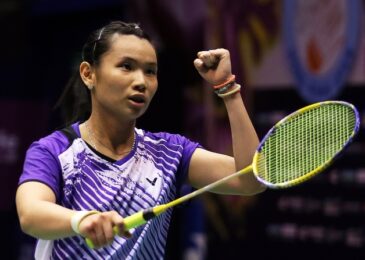The Chinese national team has seen an interesting evolution in recent years with the addition of international expertise. One notable example is Kang Kyung Jin, the former head coach of Korea, who now leads China’s women’s doubles. Another crucial member is Spain’s Cristian Luque Manjon, who serves as the strength and conditioning coach for China’s top mixed doubles pair, Zheng Si Wei and Huang Ya Qiong. Manjon has been with the team for five years, and his exclusive focus has been on Zheng and Huang since the Tokyo Olympics.
In a two-part interview, Manjon sheds light on how he entered the world of badminton, the differences between badminton and tennis, and his approach to working with the world’s best mixed doubles pair. Let’s dive into the first part of the interview to learn more about his journey and experiences.
Bạn đang xem: News | BWF World Championships
How did your association with the Chinese badminton team begin?
Manjon’s journey with the Chinese badminton team started when he was working at a tennis academy in China. A colleague who joined the badminton team recommended him for the role of strength and conditioning coach for the mixed doubles players. Manjon started working with Zheng Si Wei and Huang Ya Qiong, as well as Wang Yi Lyu, Huang Dong Ping, and Chen Yu Fei.
What were the main differences in tennis and badminton that you had to adjust to?
While there are differences between tennis and badminton, such as court size and intensity, Manjon found that many racket sports share common elements. As it was his first experience with badminton, he conducted extensive research to understand the physiological demands and specific characteristics of the sport. Although there were some adjustments, Manjon was able to apply many of the methodologies he used with tennis players to his work with the badminton team.
Was it more challenging for badminton, given that badminton players also move in the air and backwards, which tennis players don’t?
Xem thêm : Badminton Pan America
In mixed doubles, the movement patterns differ based on gender and playing style. For women, lateral movements are crucial, while men’s movements vary depending on their game style. In the case of Zheng Si Wei and Huang Ya Qiong, Ya Qiong covers the front of the court, while Si Wei covers the rest. Each player has different physical demands, and Manjon tailors the training to their individual needs.
So your work is very player-specific.
Indeed, Manjon believes in individualizing the training based on various factors, such as injuries, playing style, and training preferences. He is responsible for strength and conditioning, as well as injury rehabilitation, warm-up routines, and competition preparation.
Before you joined, they must have been following a system. Was there a lot of difference between what they were doing and the ideas you brought in?
When joining the Chinese team, Manjon understood the importance of respecting the existing system and culture. He gradually introduced minor changes, focusing on warm-up routines and competition preparation. Manjon believes in involving the players in decision-making and explaining the reasoning behind the training methods. The coaches provided him with the freedom to develop his own training methodology while ensuring support and collaboration.
Zheng and Huang were already so good before you joined the team. So what exactly did you work on with them?
As the world’s number one mixed doubles pair, Zheng Si Wei and Huang Ya Qiong aimed for consistency and maintaining their physical condition throughout the season. After tournaments, the focus shifted to recovery before adjusting the training load again. Manjon tailored the training based on each player’s strengths and weaknesses. For Ya Qiong, it involved improving lateral movements and hand-eye coordination, while for Si Wei, the focus was on injury prevention, strength development, and post-competition recovery. Additionally, Manjon emphasized the importance of rest and sleep as part of their overall training.
They have been No.1 for many years. What special qualities do they have that’s helped them maintain that level?
Xem thêm : News | BWF Thomas & Uber Cup Finals
Mental strength plays a crucial role in Zheng and Huang’s continued success. They have faced challenging situations and managed to stay calm and perform well under pressure. Their strong mentality allows them to overcome difficult moments and maintain their focus.
Can this mental stability be trained?
According to Manjon, mental stability can be trained by maintaining maximum effort and focus during daily training sessions. When athletes consistently bring intensity and concentration to their training, they are better equipped to apply those skills to competitions.
Stay tuned for Part 2 of the interview to learn more about Cristian Luque Manjon’s journey and his remarkable work with the Chinese badminton team.
FAQs
Q: How did Cristian Luque Manjon join the Chinese badminton team?
A: Cristian Luque Manjon joined the Chinese badminton team through a colleague who recommended him for the position of strength and conditioning coach for the mixed doubles players.
Q: What were the main differences in training between tennis and badminton for Manjon?
A: While there are differences in court size and intensity, Manjon found that many elements in racket sports are similar. He conducted thorough research to understand the specific demands and characteristics of badminton before applying his training methodologies.
Summary
In recent years, the Chinese national badminton team has embraced international expertise, such as Kang Kyung Jin and Cristian Luque Manjon. Manjon, a strength and conditioning coach, joined the team five years ago and has been exclusively working with the top mixed doubles pair, Zheng Si Wei and Huang Ya Qiong. In part one of the interview, Manjon shared his journey and experiences, highlighting the individualized approach he takes to training. He emphasized the importance of maintaining consistency, injury prevention, and mental strength to sustain their performance. Stay tuned for part two to learn more about Manjon’s work and insights. For more information and updates, visit Carnegiecentre.com.
Nguồn: https://carnegiecentre.com
Danh mục: Tin tức


